Winter Chanterelle – Edibility, Identification, Similar species, Distribution, Ecology, Harvesting, Usage
Craterellus tubaeformis, AKA Trumpet Chanterelle or Yellowlegs (US)
- Edibility: 4/5 – Great earthy flavour that belies their flimsy appearance
- Identification: 4/5 – Quite distinctive, but can be confused with several other similar, closely related, hollow-stemmed edible species that are often referred to as, winter chanterelles below. Referring to C.tubaeformis as Trumpet chanterelle helps to avoid confusion.
- Distribution: 3/5 – Reasonably common (though easily missed) and often occurring in large numbers where established
- Season: September – January. “Winter” chanterelle is something of a misnomer as they stop growing after the first heavy frost, but being an insect resistant fungi, fruit bodies often persisting for some time after that. Certainly they tend to appear later than true chanterelles (which are predominantly a summer mushroom in Scotland).
- Habitat: Under spruce, pine, western hemlock, beech or (less commonly) oak, with a preference for heavy leaf/needle cover and particularly moist slopes. Often blaeberry/bilberry is present.
- Ecology: Mycorrhizal, helping tree partners in the uptake of water and nutrients in exchange for simple sugars. Largely unappealing to both insects and slugs, though the hollow stems can be home to fast-moving millipedes! More on the ecology of slower-growing, insect resistant mycorrhizal mushrooms here.
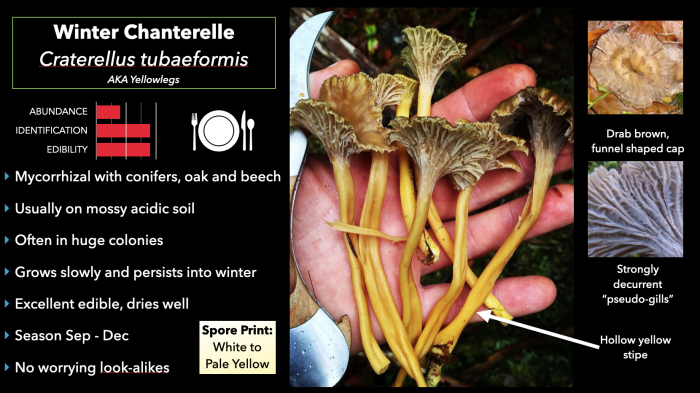
Winter Chanterelle infographic. I discuss winter chanterelles on my “20 Mushrooms to learn before you die” Webinar. Image ©GallowayWildFoods.com
Several similar species to craterellus tubaeformis are often lumped together as “winter chanterelles”. Most of these were previously grouped under the cantharellus genus, but most of these hollow-striped, pseudo-gilled species have recently been reclassified as craterellus. They all like similar habitats, and can be used in the same way in the kitchen. Here is a quick rundown:
Golden chanterelle (craterellus aurora aka craterellus lutescens).
Somewhat rarer than the trumpet chanterelle. Distinguished by wrinkled surface on the underside of the cap rather than pseudo-gills of c.tubaeformis. Don’t allow the name to confuse you with the much more stocky and distinctive “true” chanterelle, cantharellus cibarius, which is golden/orange all over, much more solid, and lacking a hollow stipe.
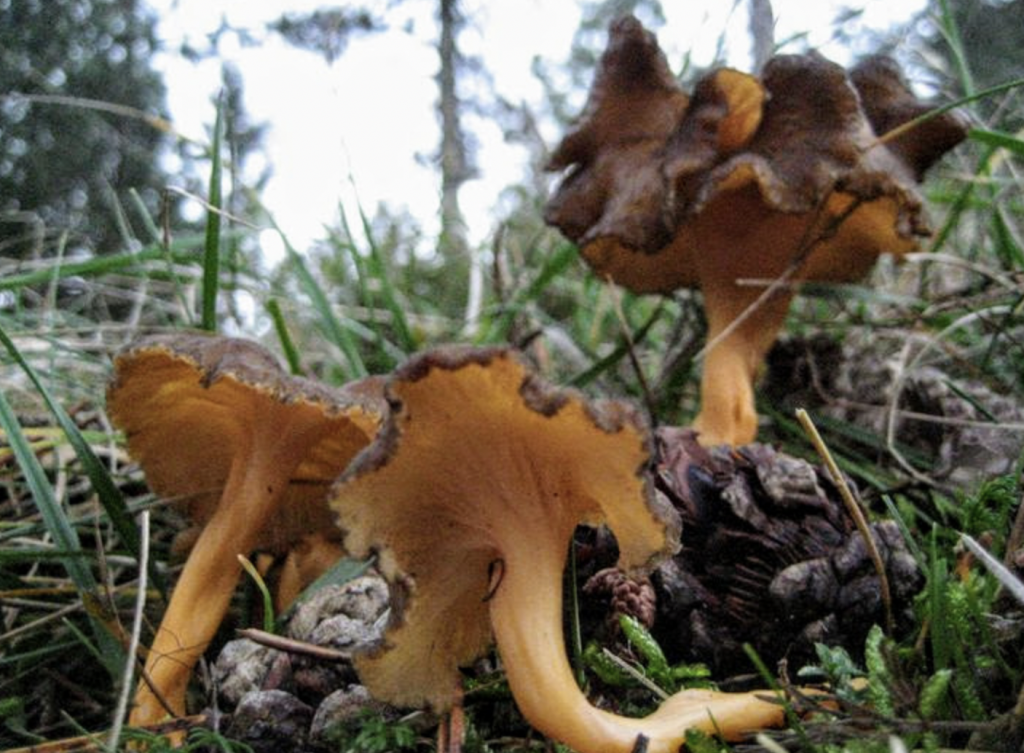
Golden chanterelle, craterellus aurora. Very similar to Craterellus tubaeformis but lacks even ‘pseudo gills’, instead having vague wrinkles. Like all of the chanterelle group, the entire underside of the cap and much of the stipe produces spores. Image: Prirodnjak, via Wiki
Ashen chanterelle (craterellus cinereus)
Similar to c. tubaeformis, but lacks any yellow colouration. From above they can resemble horn of plenty (craterellus cornucopoides), but the presence of pseudo gills-on the underside of the cap distinguishes them from entirely gill-less horn of plenty. Ashen chanterelles are edible in the same manner as other mushrooms on this page that fall vaguely under the “winter chanterelle” banner. They are not commonly reported in the UK, though this may well be due to the difficulty of spotting them among leaf litter. I am yet to find them in SW Scotland.
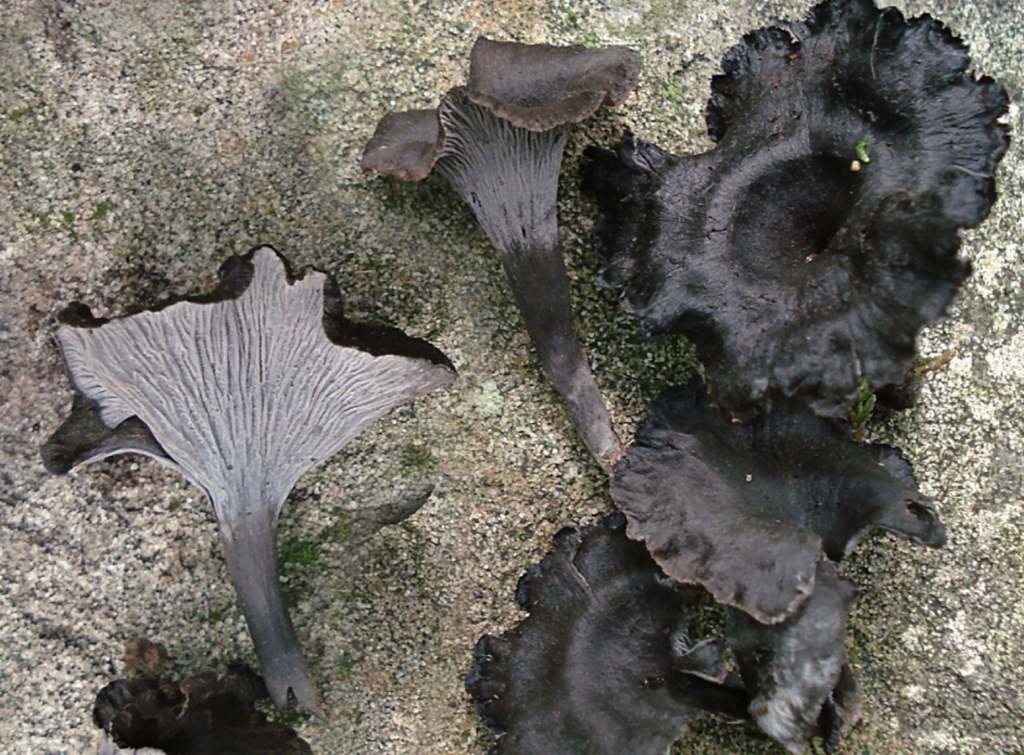
Ashen chanterelle, Craterellus cinereus. Lacking any orange/yellow colouration and rather like horn of plenty (craterellus cornucopoides), but distinguished by having wrinkles under the cap while horn of plenty has not even a hint of gills. Image source: Mushroom Observer via Wiki.
Sinuous chanterelle, aka wavy-capped chanterelle (Pseudocraterellus undulatus)
Similar to the golden chanterelle, having only vague wrinkles instead of gills, but lacks any yellow or orange colouration. It tends to grow in clumps with its wavy caps overlapping and interlocking.
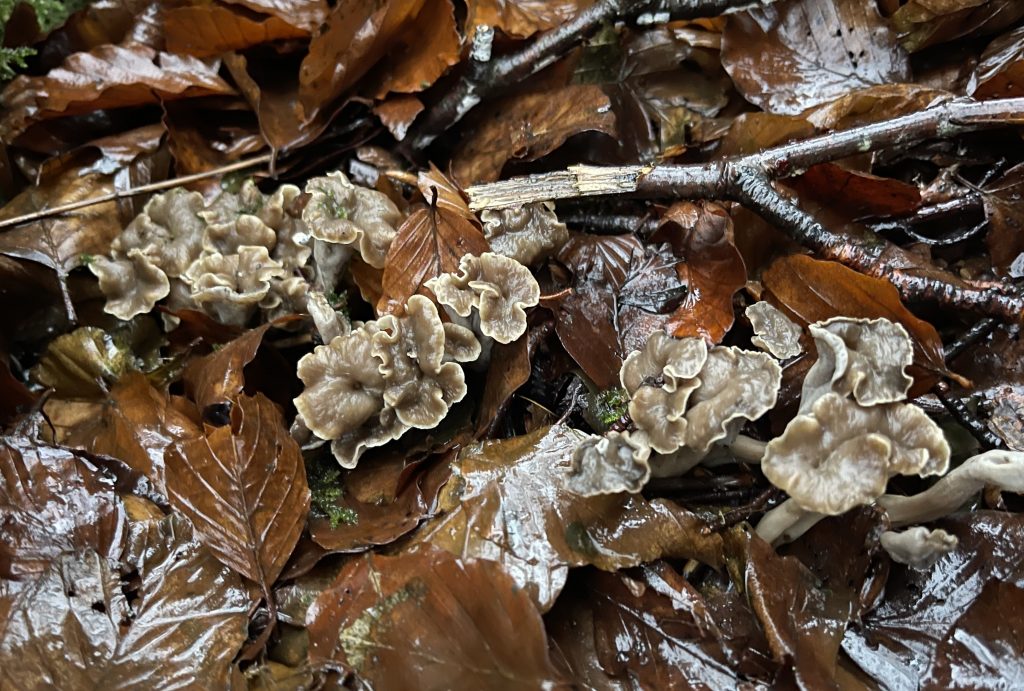
Sinuous chanterelle, pseudocraterellus undulatus. Growing in typically tightly packed interlocking wavy-edged clumps. December, Galloway. Image ©GallowayWIldFodds.com
Sinuous chanterelles appear to be less common than trumpet chanterelles (c.tubaeformis), but quite likely to be under reported. I find plenty around Galloway, often near trumpet chanterelles, chanterelles or hedgehog mushrooms, and wonder if they form myco-myco as well as mycorrhizal relationships. Sinuous chanterelles are edible in the same way as other craterellus species, though tend to be wet and more flimsy.
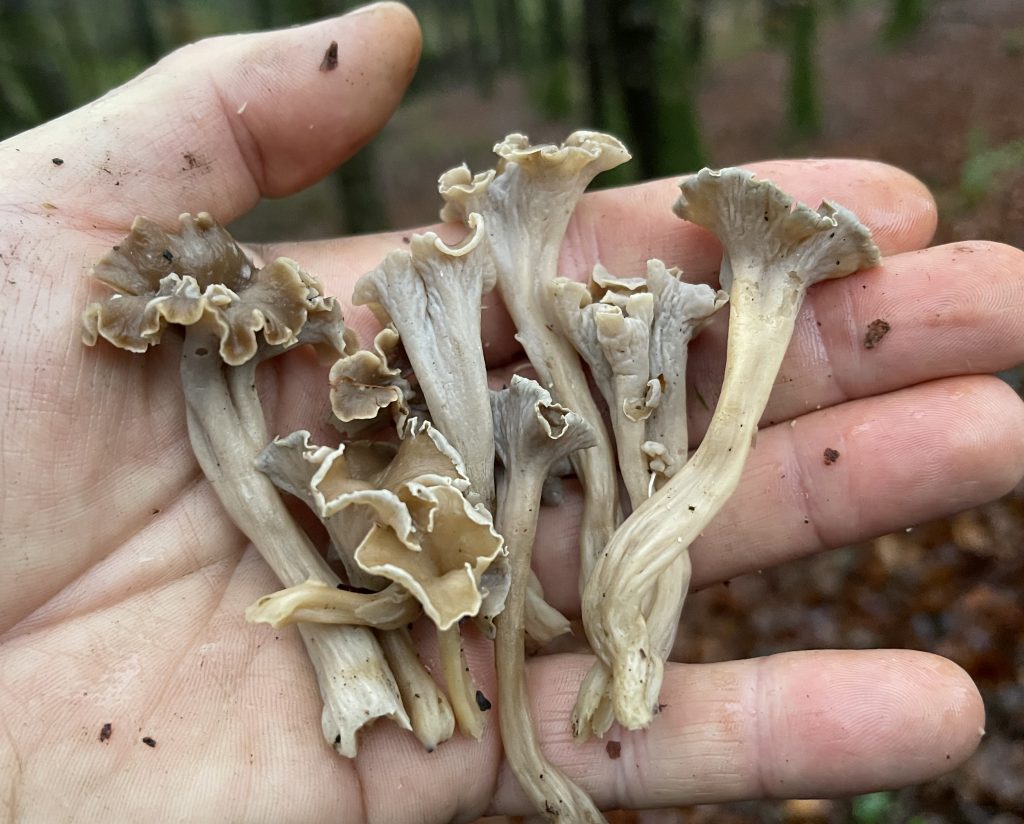
Sinuous chanterelle, pseudocraterellus undulatus. Note the flamboyant cap edges, lack of yellow colouration and wrinkles rather than pseudo gills. Image ©GallowayWildFoods
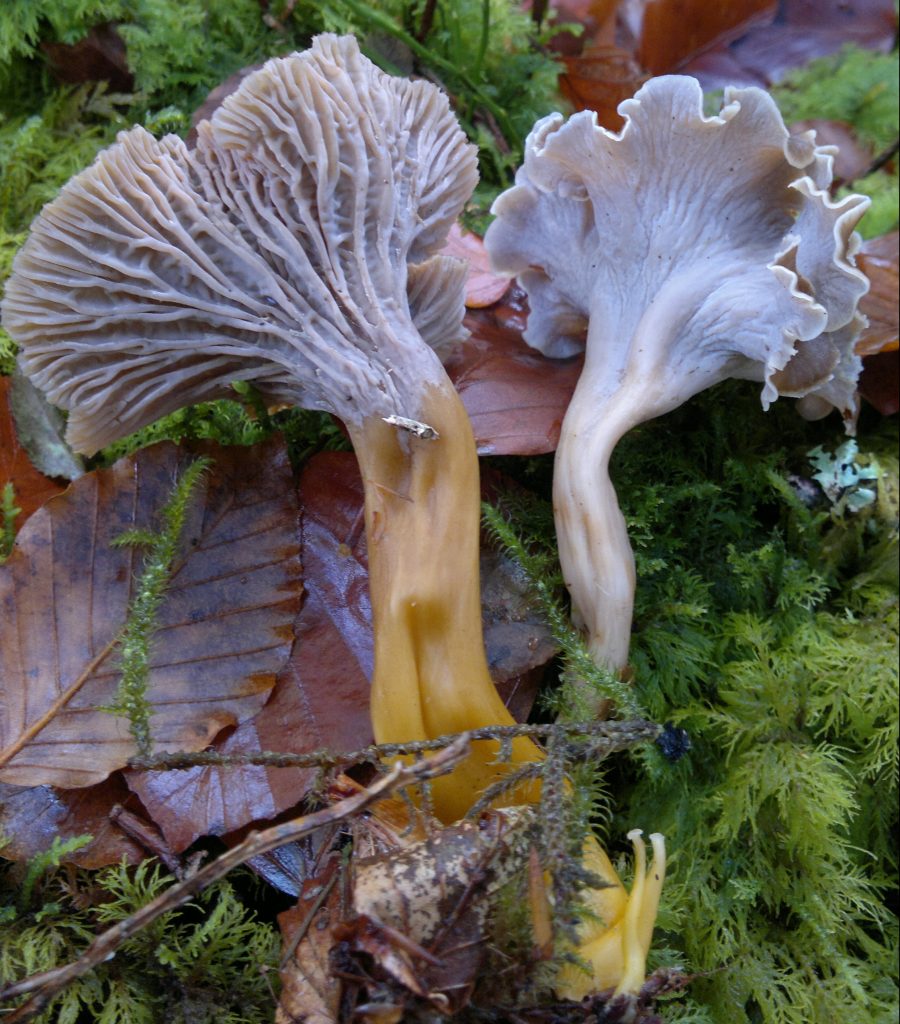
(Left) Winter chanterelle aka yellowlegs (craterellus tubaeformis) v (Right) Sinuous chanterelle (pseudocraterellus undulatus)
The trumpet chanterelle is a common, easy to identify and delicious mushroom that can be picked in large numbers right through November and well into December in most of the UK.
With their drab brown caps (3-7cm across) and flimsy flesh, winter chanterelles aren’t so glamorous as the true yolky-golden chanterelle (Cantharellus Cibarius), at least not at first sight. But once you look below the cap, their veined pseudo-gills, and orange stripes are truly beautiful – every one an individual work of art. A basket of winter chanterelles has to be one of the prettiest sights of autumn.
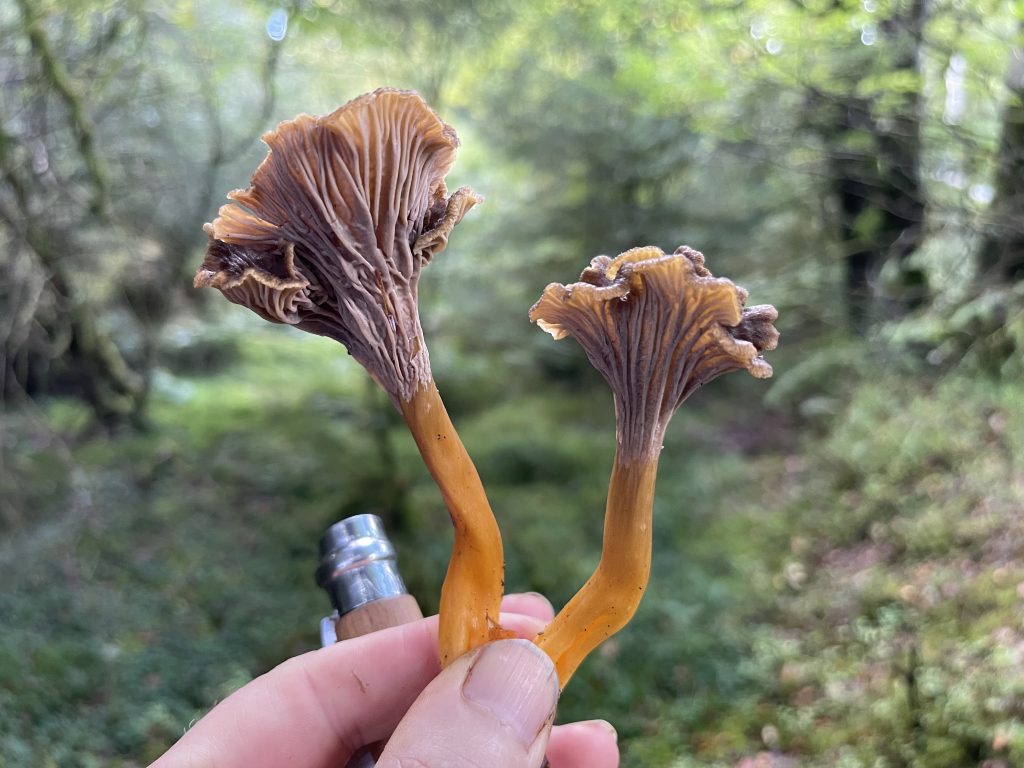
Winter chanterelle, trumpet chanterelle, craterellus tubaeformis. Each one a work of art!
©GallowayWildFoods.com
Confusingly, the French refer to our chanterelles as girolle and winter chanterelles as chanterelles. Thats why you will often find up-market restaurants selling girolle. As if the world of wild mushrooms wasn’t confusing enough! This is why scientific names are really useful sometimes – although even they change quite regularly as scientists re-categorise (not so long ago, C. Tubaeformis was known as Cantherellus infundibuliformis).
Fortunately, once you look beneath the wavy, irregular cap, identification becomes much easier.
Most obvious is the bright yellow/orange stem which gives the common name of yellow-leg. The beige gills are also distinctive by being vein-like rather than deeply grooved (think combed plastercene) on trumpet chanterelles, or even less substantial wrinkles in the case of golden chanterelles. These two species are so similar to the non-scientist that in this instance it isn’t crucial to distinguish between them – both are good eating mushrooms with a sweet fruity scent (you need to stick your nose in a basketful to smell this) and a delicate, earthy flavour. A final identification feature is the funnel-like cap and hollow stem of fully grown specimens.
Spotting the dingy caps of winter chanterelles in leaf-strewn woodland can be incredibly difficult – even if you know where you are looking. I return every year to a specific tree beneath which I know they will be growing, but it can still take several minutes to spot the first one. Then, as so often occurs while foraging, my eyes seem to tune into the right wavelength and dozens of mushrooms magically emerge from the leaf litter.
View this post on Instagram
Where established, they can occur in large numbers – I once found a densely packed foot wide pathway of them forming a huge ring. In the exact centre of the ring was a large and perfectly formed penny bun. No wonder mushrooms are often associated with fairies!
Winter chanterelles are “multilingual” mycorrhizal fungi, mostly grow in association with conifers, especially beneath spruce, pine and western hemlock, though I find plenty under beech and oak too. You can find vast numbers of them in those large, soulless deserts of sitka that support very little else (mushrooms don’t need light to thrive). In my experience they prefer habitats with a good damp covering of moss and leaf or needle litter.
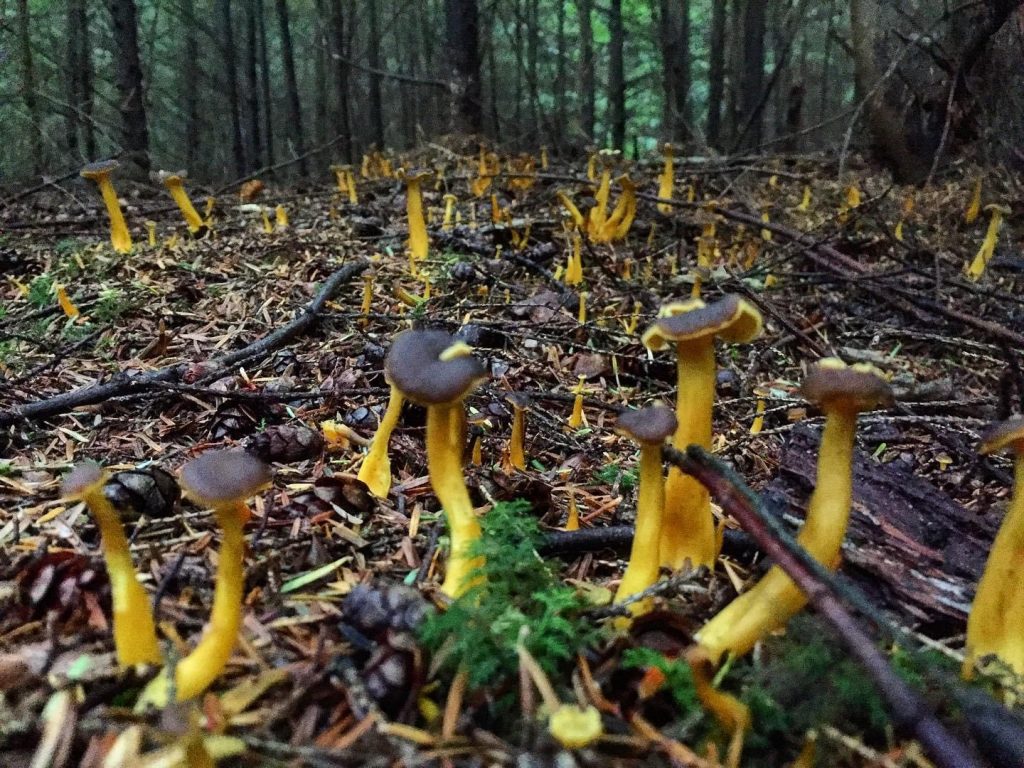
Winters Is Coming!
Winter chanterelles can appear in huge colonies. They are easier to spot in the needle litter under conifers. This image shows young specimens, just starting.
Image ©GallowayWIldFoods
As a relatively slow-growing, insect-resistant, slow-to-rot mushroom, much of my discussion in this post about about (true) chanterelles also applies to winter chanterelles.
Despite their flimsy texture, winter chanterelles, are one of our finest edible wild mushrooms, and can vastly improve any mushroom dish. They have a high water content so I sometimes resort to wringing them out before cooking or drying, which adds to their fridge life, and saves them from going off if drying isn’t rapid.
Roast/fry them quite hard once you have driven off most of the moisture. Their slippery texture and earthy flavour make them a natural partner in creamy, garlicy sauces – especially with linguine. They grow during the pheasant shooting season and fit naturally in any game casseroles, pies or stews
Winter chanterelles pickle well – see my guidance on how to pickle wild mushrooms here.
Recipe: Pheasants with winter chanterelles and root vegetables
If you are lucky enough to find some, the chances are you will gather enough for more than one meal. I recommend preserving gluts by lightly simmering in a 3:2:1 in vinegar solution (3 parts water, 2 parts cider vinegar, 1 part sugar) then preserving in oil, or sauté in butter then freeze. They also dry quite quickly and well in a dehydrator, warm, airy space, or in a very low fan oven with the door left slightly open.
Related Posts:
- Edible wild fungi guide
- In Season Now
- An Introduction to Fungi Foraging
- How to pickle wild mushrooms
- Winter Foraging
- Learn To Forage
- Relatively Slow Growing, Insect Resistant Mushrooms
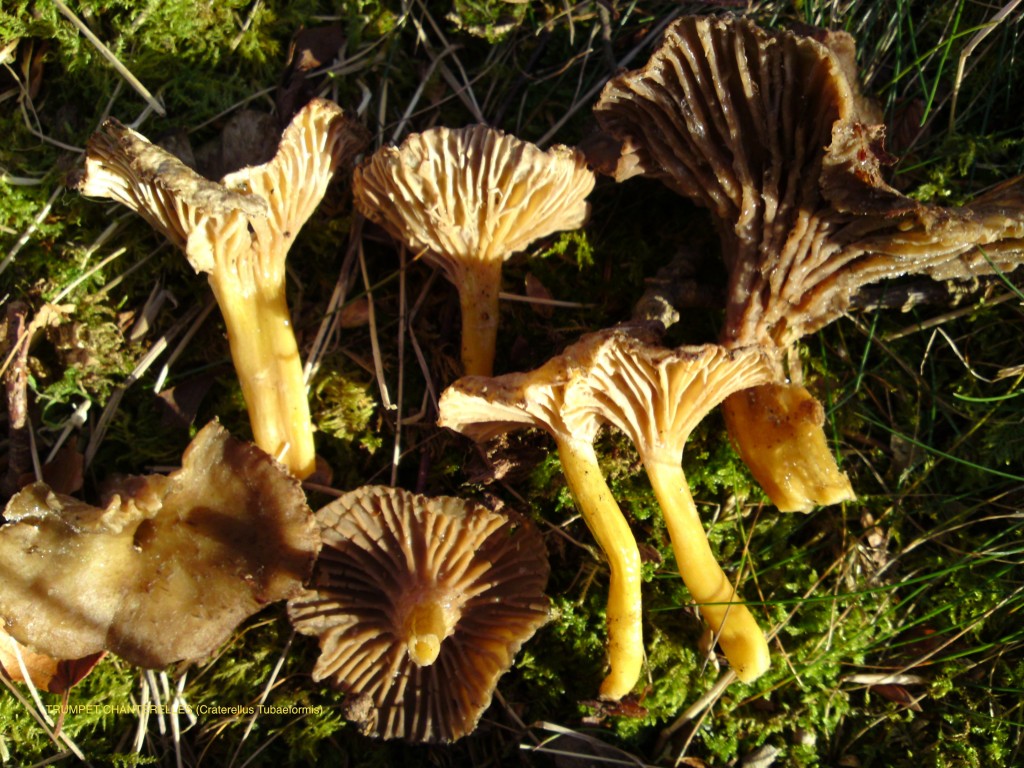
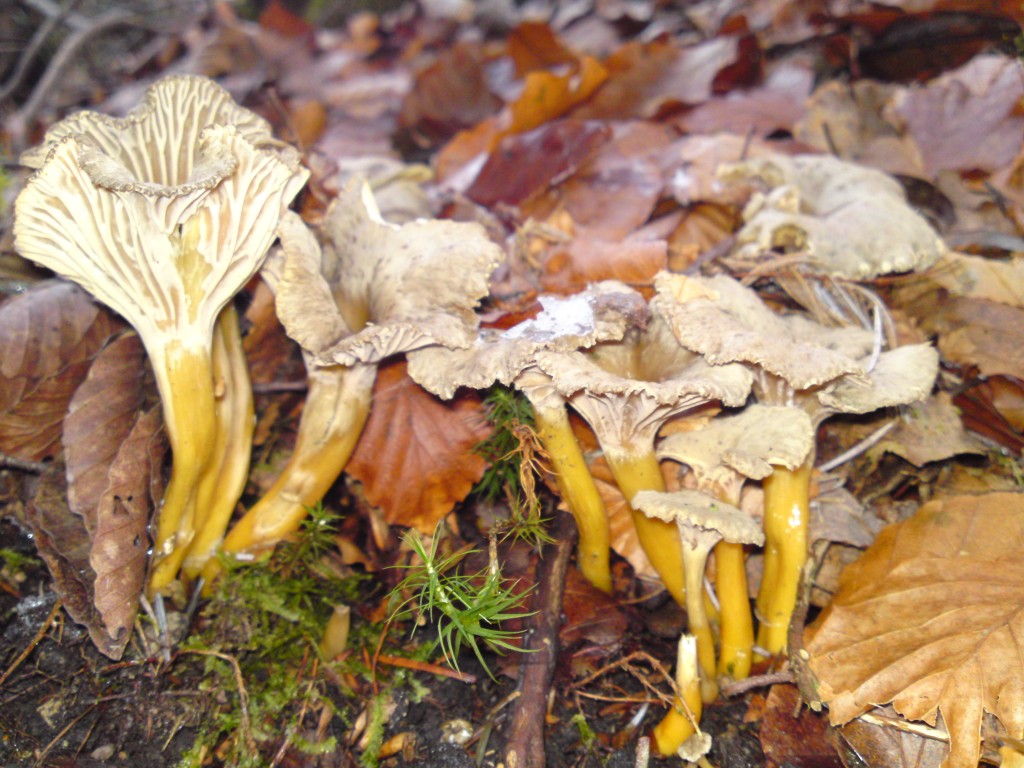

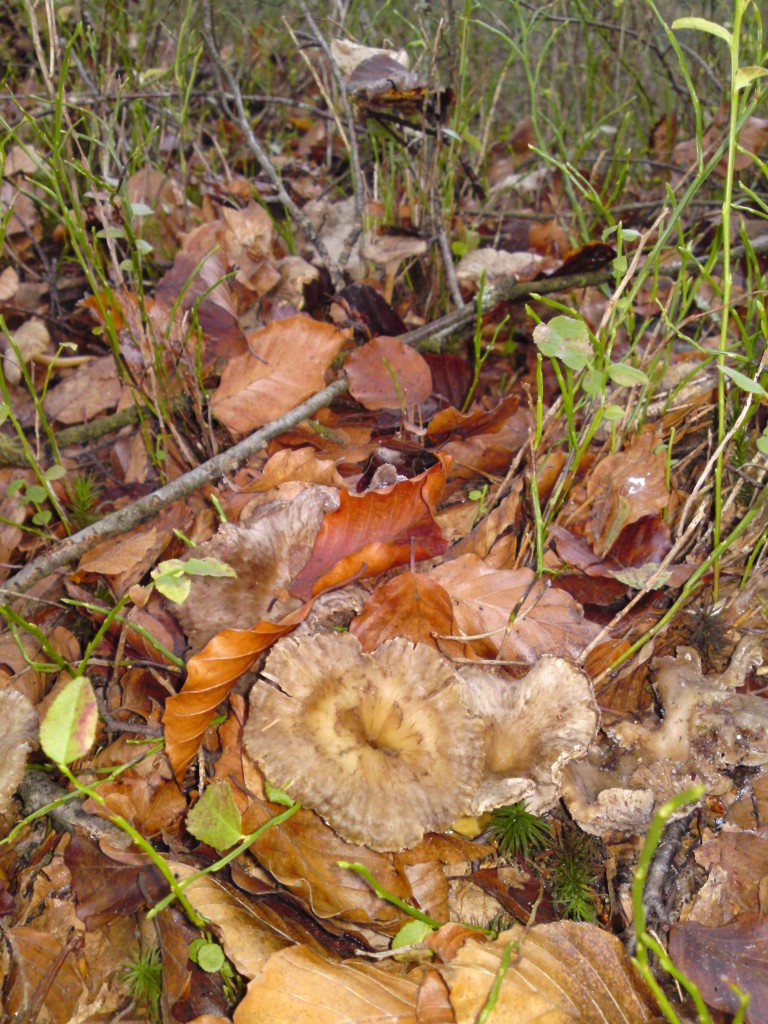

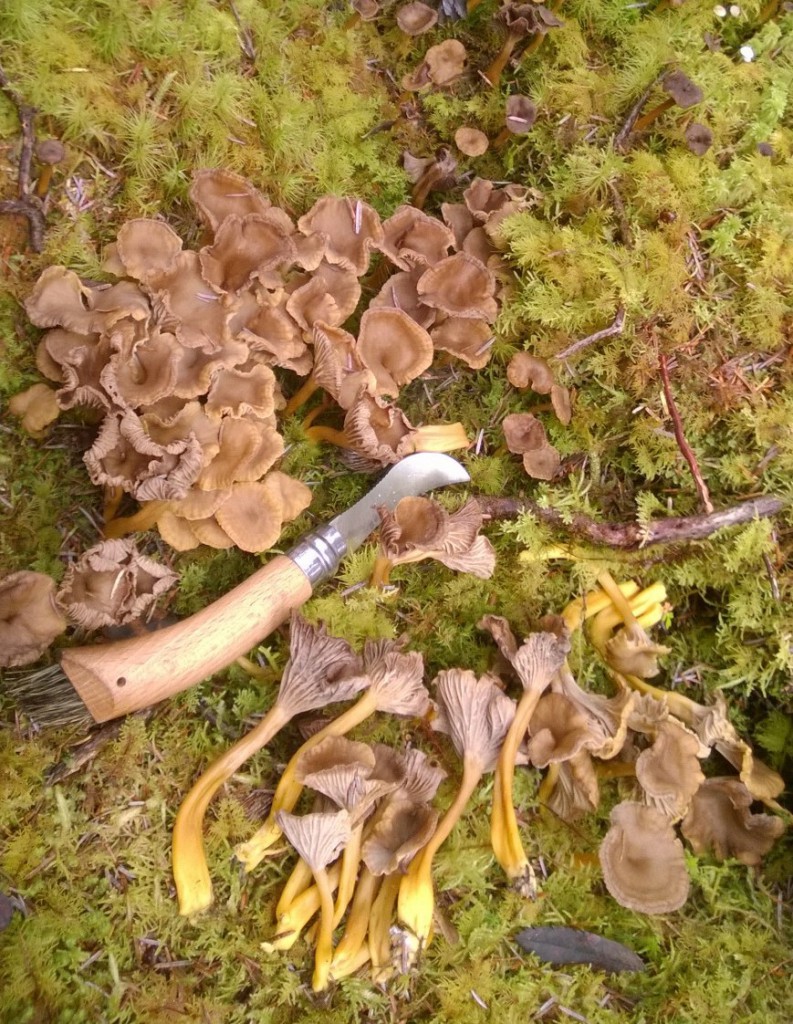
22 Comments
I have just found a fabulous patch in the french alps – a steep ravine with moss. However, as I am new to mushroom foraging, can you tell me if I can pick from the same patch again and again in a season, and how long should I leave between pickings? Thank you.
Winter chanterelle mycelia can be vast, with different parts “fruiting” at different times, so it is worth revisiting the spot. If carefully harvested, with minimal trampling, it will fruit for many years.
Do you have notes on foraging mushrooms in the LI, NY area?
No sorry.
Mark, so chanterelles are terrible when dried, BUT you’re saying that Winter Chanterelles can be dried and it does not adversely effect the taste?
Pretty much…though I wouldn’t say chanterelles were terrible dried – just a shadow of their former glory! Winter chants dry and reconstitute most excellently
I agree. I much prefer lightly frying in butter and a bit of oil and then freezing them to retain that lovely fruity flavour.
Brian Sephton – just found about 1000 of these and I’m drying some. Tried some in a white sauce with onion and they were excellent. What is your recipe?
Hi Sorry I don’t visit here enough but the recipe is :-
1 litre of winter chanterelles dehydrated in a frying pan until the water has stopped bubbling from them .Add then to a crock pot with 1 litre of beef stock -you can use veggie but we prefare the taste -a small tin of tomato puree and a block of roquefort cheese (we will only use Roquefort having tried lots of different blues ) use a small amount of thickening ( cornflower,maize flour or ordinary flour but then you must make a roux to acheive the consistency of the soup you prefer .Then add 2 dl of double cream Then add the juice of half of a lemon just before serving .Sprinkle with fresh parsley as you serve ,If you want to spoil yourself serve with cheese on toast slices ,we use Cheddar for those.
Please don’t make this for a visit of friends as you will begrudge all they take ,every drop
agree with your last sentence!
I agree, a five star mushroom. They dry very well here in Finland. I pull them apart straight down the middle and lay them on paper and within 2 to 3 days they are dry . I happily try your recipe.
I do exactly the same. I’ve still got some from last winter, frozen after drying, and they are still excellent
Just found a huge bounty in the mountains here in Vermont, northeastern US this morning. Found them with what appears to be terra-cotta hedgehogs.
Im in Cardiff (Wales, UK), and I find terracotta hedgehogs growing with sinuous chanterelles and the odd girolle too. The forest is pretty large and all three grow together in one little spot even though they dont appear elsewhere in the forest
Just found a great quantity in the woods near my home, in Ontario, north of Lake Superior. I have visited the same spot several years now, and this year is the best yet! In the past, I’ve picked them through the snow, in to October, after that it gets too cold up here. Love the flavor!
I managed to finally find these locally, having only found them previously in the New Forest. I think it’s taken so long as they’re really so difficult to spot. You can be within a foot in eyeshot and still miss them! They seem to be growing with oak, with also some beech nearby. The ground was mossy with lots of rotting leaf litter and was very, very wet. Which maybe seems the key to finding them rather than association with specific trees. Now, what to make with them …..
I find them at the base of big eucalyptus trees. If you find one look around and you will find more close by. Excelente edible mushrooms, I prefer them to the golden cantrells but the later ones smell so nice. I heard they use them to flavor ice cream.
Just Harvested our first Bounty in late January no less. Large groups of them in the mossy slopes of North Vancouver 200m plus or minus elevation.
I love these because they’re just coming out when everything else is slowing down and disappearing. They’re the last thing I collect before our long Alaskan winter hits.
One more thing is the aroma of the dried mushrooms. It’s wonderful, sweet. Like graham crackers or a freshly baked cinnamon roll.
I have found some form of craterellis but not sure which. Caps are quite a dark brown wrinkly underside is like milky chocolate and stem dull gold. Would send photo but no idea if I can?
Hi, I buy the chanterelles d’été and they come from Estonia. 20 years ago I picked the mentioned sorts.
I find this article very good and I learned some. Thanks for that and everything. The photos help a lot and are very much appreciated .
AB
I found two separate colonies in woods in South Devon last year and added another location in close proximity this year. The “yellow legs” are easy to identify once you’ve studied them and very tasty. On beech mossy roots or between broadleaf and pine is where most grow and a wet leaf litter seems to suit them particularly well.
I came across a grey version in early October this year and at first thought they were the trumpet of death. In fact I’m sure they’re the ashen winter chantarelle.
I wouldn’t have found these species a few years ago but annual fungi season forays have given me a sense of when and where to look, and to search slowly and carefully.